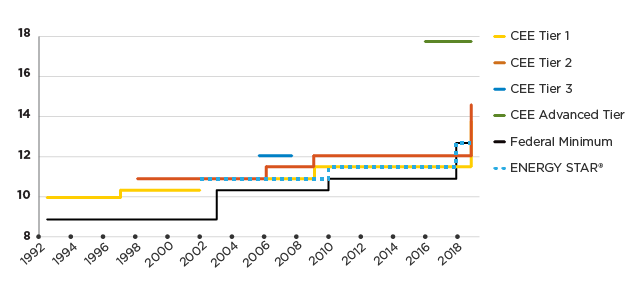

Strong CEE member support for the CEESM High Efficiency Commercial Air Conditioning and Heat Pumps Initiative (HECAC Initiative) and its accompanying specification has led the way for commercial unitary air conditioning (AC) and heat pump (HP) efficiency since the Initiative’s creation in 1993. Through the Initiative, members push market development of super efficient HVAC systems forward, spurring industry norms and expectations for ever-greater efficiency. Steady increases in CEE tier criteria (accompanied by corresponding utility incentives) blazed a trail for four increases in US federal minimum AC and HP equipment standards since 1993, which have increased minimum equipment efficiencies over the original standards by over 40 percent.
| While new federal standards that took effect in January 2018 are expected to result in net savings of 14.1 quads between 2018 and 2048, with a net present value ranging from $15.2 billion to $50 billion depending on discount rate, the savings opportunity is far from fully realized. The Department of Energy estimates that an additional 8.3 quads of energy savings is achievable beyond the new standards. In May, the CEE Board of Directors approved enhancements to the CEE Initiative that map a route for programs to achieve these further savings. |
DOE estimates that an additional 8.3 quads of energy savings is achievable beyond 2018 federal standards. |
In the figure below, the
federal minimum and ENERGY STAR are displayed in EER until 2018 and in
IEER afterwards; CEE Tiers 1, 2, and 3 are displayed in EER until 2019
and in IEER afterwards. The CEE Advanced Tier is displayed in IEER
throughout.

Commercial space cooling is a priority area for ratepayer funded energy efficiency programs, representing 7.6 percent of commercial building energy consumption and the second largest contribution to the sector’s coincident summer peak demand. Unitary AC and HP equipment serves over 50 percent of commercial building floor space and accounts for approximately 60 percent of cooling and heating energy consumption. To address this opportunity, CEE members work through the HECAC Initiative to address market and program barriers, such as high first cost, and advance the efficiency of commercial AC and HP equipment.
The Initiative includes a multitiered performance specification for unitary and variable refrigerant flow (VRF) multisplit AC and HP equipment, defining efficient performance on a peak and seasonal basis. The tiered system differentiates among levels of efficiency. Identifying top performing product lines, the Advanced Tier establishes a basis to promote unitary AC that demonstrates super efficient part load performance. Through consistent and widespread member program support for CEE tiers—sixty-one participated in the Initiative in 2017—CEE has helped drive market demand for efficiency.
The newly approved Initiative revisions, scheduled to go into effect in 2019, advance the unitary AC and HP specification for three performance tiers encompassing equipment 5.4 tons and greater in cooling capacity.
The 2019 specifications represent:
| Compared to models just meeting the 2018 federal minimum, models meeting the revised CEE spec offer cooling energy savings ranging from five to 28 percent. |
Through evolutionary changes in the Initiative, the Consortium maintains a targeted presence in the commercial HVAC market in order to continue capturing savings above federal minimums. Compared to models just meeting the 2018 federal minimum requirement, equipment meeting the 2019 specifications offers cooling energy savings ranging from five to 28 percent depending on tier, equipment type, and size category. |
As is typical of CEE initiatives, the HECAC Initiative embodies a flexible approach that accounts for the impact of climate variability on HVAC performance and for member programs’ various objectives and drivers. The best metric for cooling performance, controlling humidity, and managing peak demand on the grid may vary from place to place depending on local peak conditions and climate, so member programs may promote either the full load metric (EER), the part load metric (IEER), or both metrics as a basis for participation.
Future Initiative enhancements may include the addition of connected criteria for variable capacity AC and HP systems to realize new potential customer and grid benefits. If variable capacity system modulating capabilities can be automated, easily coupled with utility load management programs, and supported by the necessary communication capabilities, they could assist in system load balancing, integrating DERs, providing visibility relative to load conditions, and improving use of existing system assets.
For additional details, contact Program Manager Bjorn Jensen.
Erratum: This story previously cited incorrect figures for projected savings from 2018 federal standards and for DOE estimates of possible additional savings. These numbers were corrected on August 7, 2018.
About CEE
CEE is an award-winning consortium of
efficiency program administrators from the United States and Canada.
Members work to unify program approaches across jurisdictions to
increase the success of efficiency in markets. By joining forces at CEE,
individual electric and gas efficiency programs are able to partner not
only with each other, but also with other industries, trade
associations, and government agencies. Working together, administrators
leverage the effect of their ratepayer funding, exchange information on
successful practices and, by doing so, achieve greater energy efficiency
for the public good.